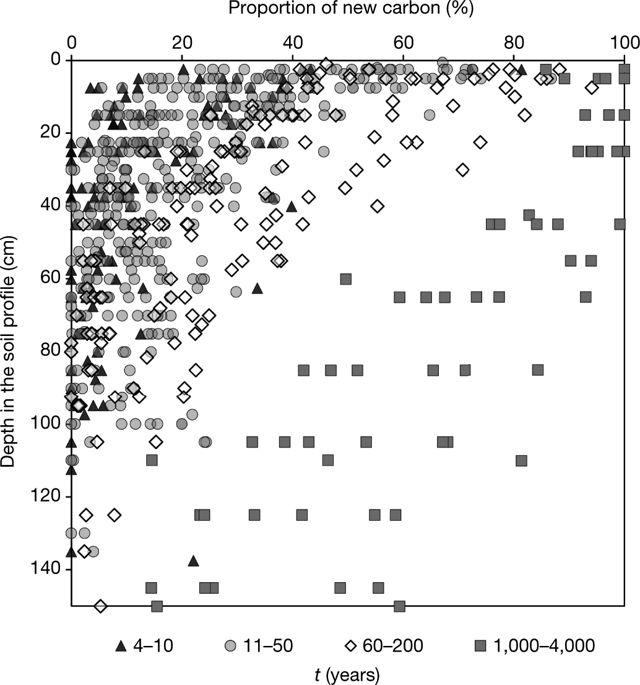Our official English website, www.x-mol.net, welcomes your feedback! (Note: you will need to create a separate account there.)
Atmosphere–soil carbon transfer as a function of soil depth
Nature ( IF 64.8 ) Pub Date : 2018-07-01 , DOI: 10.1038/s41586-018-0328-3 Jérôme Balesdent 1 , Isabelle Basile-Doelsch 1 , Joël Chadoeuf 2 , Sophie Cornu 1 , Delphine Derrien 3 , Zuzana Fekiacova 1 , Christine Hatté 4
Nature ( IF 64.8 ) Pub Date : 2018-07-01 , DOI: 10.1038/s41586-018-0328-3 Jérôme Balesdent 1 , Isabelle Basile-Doelsch 1 , Joël Chadoeuf 2 , Sophie Cornu 1 , Delphine Derrien 3 , Zuzana Fekiacova 1 , Christine Hatté 4
Affiliation

|
The exchange of carbon between soil organic carbon (SOC) and the atmosphere affects the climate1,2 and—because of the importance of organic matter to soil fertility—agricultural productivity3. The dynamics of topsoil carbon has been relatively well quantified4, but half of the soil carbon is located in deeper soil layers (below 30 centimetres)5–7, and many questions remain regarding the exchange of this deep carbon with the atmosphere8. This knowledge gap restricts soil carbon management policies and limits global carbon models1,9,10. Here we quantify the recent incorporation of atmosphere-derived carbon atoms into whole-soil profiles, through a meta-analysis of changes in stable carbon isotope signatures at 112 grassland, forest and cropland sites, across different climatic zones, from 1965 to 2015. We find, in agreement with previous work5,6, that soil at a depth of 30–100 centimetres beneath the surface (the subsoil) contains on average 47 per cent of the topmost metre’s SOC stocks. However, we show that this subsoil accounts for just 19 per cent of the SOC that has been recently incorporated (within the past 50 years) into the topmost metre. Globally, the median depth of recent carbon incorporation into mineral soil is 10 centimetres. Variations in the relative allocation of carbon to deep soil layers are better explained by the aridity index than by mean annual temperature. Land use for crops reduces the incorporation of carbon into the soil surface layer, but not into deeper layers. Our results suggest that SOC dynamics and its responses to climatic control or land use are strongly dependent on soil depth. We propose that using multilayer soil modules in global carbon models, tested with our data, could help to improve our understanding of soil–atmosphere carbon exchange.This study of whole-soil carbon dynamics finds that, of the atmospheric carbon that is incorporated into the topmost metre of soil over 50 years, just 19 per cent reaches the subsoil, in a manner that depends on land use and aridity.
中文翻译:

作为土壤深度函数的大气-土壤碳转移
土壤有机碳 (SOC) 和大气之间的碳交换会影响气候 1,2 以及——由于有机物对土壤肥力的重要性——农业生产力 3。表层土壤碳的动态已得到相对较好的量化4,但土壤碳的一半位于较深的土壤层(30 厘米以下)5-7,关于这种深层碳与大气的交换仍存在许多问题8。这种知识差距限制了土壤碳管理政策并限制了全球碳模型1、9、10。在这里,我们通过对 1965 年至 2015 年跨不同气候带的 112 个草地、森林和农田地点的稳定碳同位素特征变化的荟萃分析,量化了最近将大气衍生的碳原子纳入整个土壤剖面。我们发现,与以前的工作一致 5,6,地表以下 30-100 厘米深度的土壤(底土)平均含有 47% 的最顶层 SOC 储量。然而,我们表明,这种底土仅占最近(在过去 50 年内)被纳入最高米的 SOC 的 19%。在全球范围内,近期碳进入矿质土壤的中位深度为 10 厘米。干旱指数比年平均温度更好地解释了碳在深层土壤层中的相对分配变化。农作物的土地使用减少了碳进入土壤表层,但不会进入更深层。我们的研究结果表明,SOC 动态及其对气候控制或土地利用的响应在很大程度上取决于土壤深度。我们建议在全球碳模型中使用多层土壤模块,
更新日期:2018-07-01
中文翻译:

作为土壤深度函数的大气-土壤碳转移
土壤有机碳 (SOC) 和大气之间的碳交换会影响气候 1,2 以及——由于有机物对土壤肥力的重要性——农业生产力 3。表层土壤碳的动态已得到相对较好的量化4,但土壤碳的一半位于较深的土壤层(30 厘米以下)5-7,关于这种深层碳与大气的交换仍存在许多问题8。这种知识差距限制了土壤碳管理政策并限制了全球碳模型1、9、10。在这里,我们通过对 1965 年至 2015 年跨不同气候带的 112 个草地、森林和农田地点的稳定碳同位素特征变化的荟萃分析,量化了最近将大气衍生的碳原子纳入整个土壤剖面。我们发现,与以前的工作一致 5,6,地表以下 30-100 厘米深度的土壤(底土)平均含有 47% 的最顶层 SOC 储量。然而,我们表明,这种底土仅占最近(在过去 50 年内)被纳入最高米的 SOC 的 19%。在全球范围内,近期碳进入矿质土壤的中位深度为 10 厘米。干旱指数比年平均温度更好地解释了碳在深层土壤层中的相对分配变化。农作物的土地使用减少了碳进入土壤表层,但不会进入更深层。我们的研究结果表明,SOC 动态及其对气候控制或土地利用的响应在很大程度上取决于土壤深度。我们建议在全球碳模型中使用多层土壤模块,



























 京公网安备 11010802027423号
京公网安备 11010802027423号